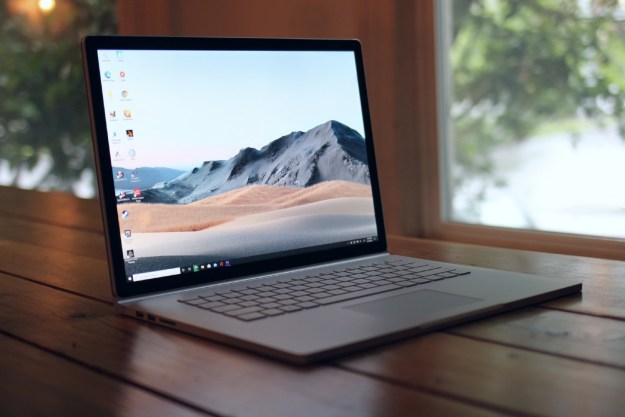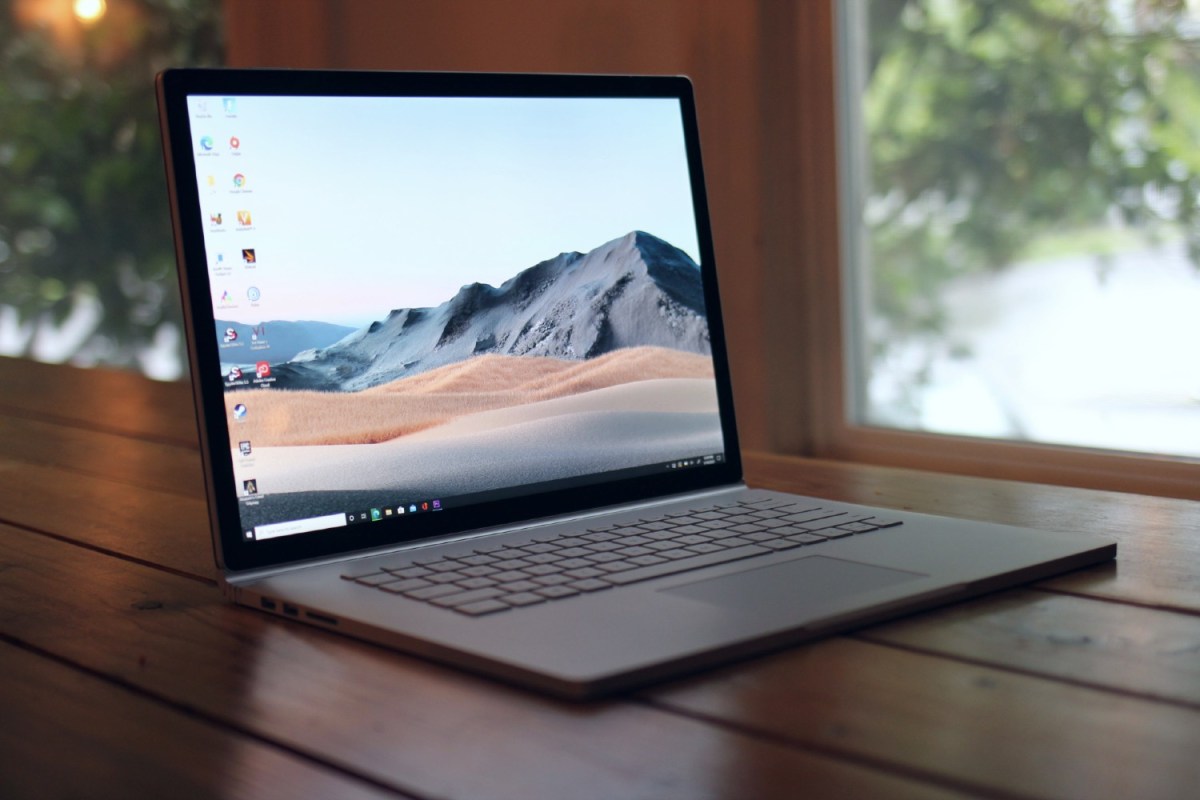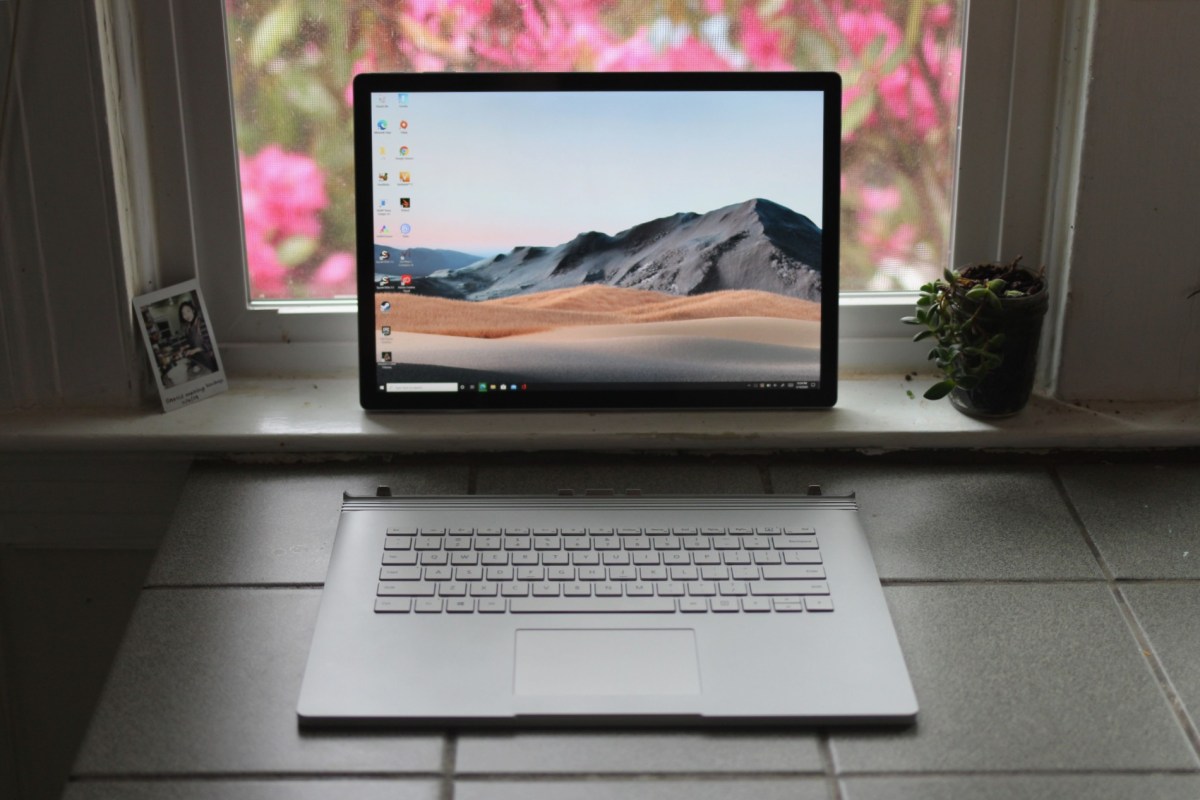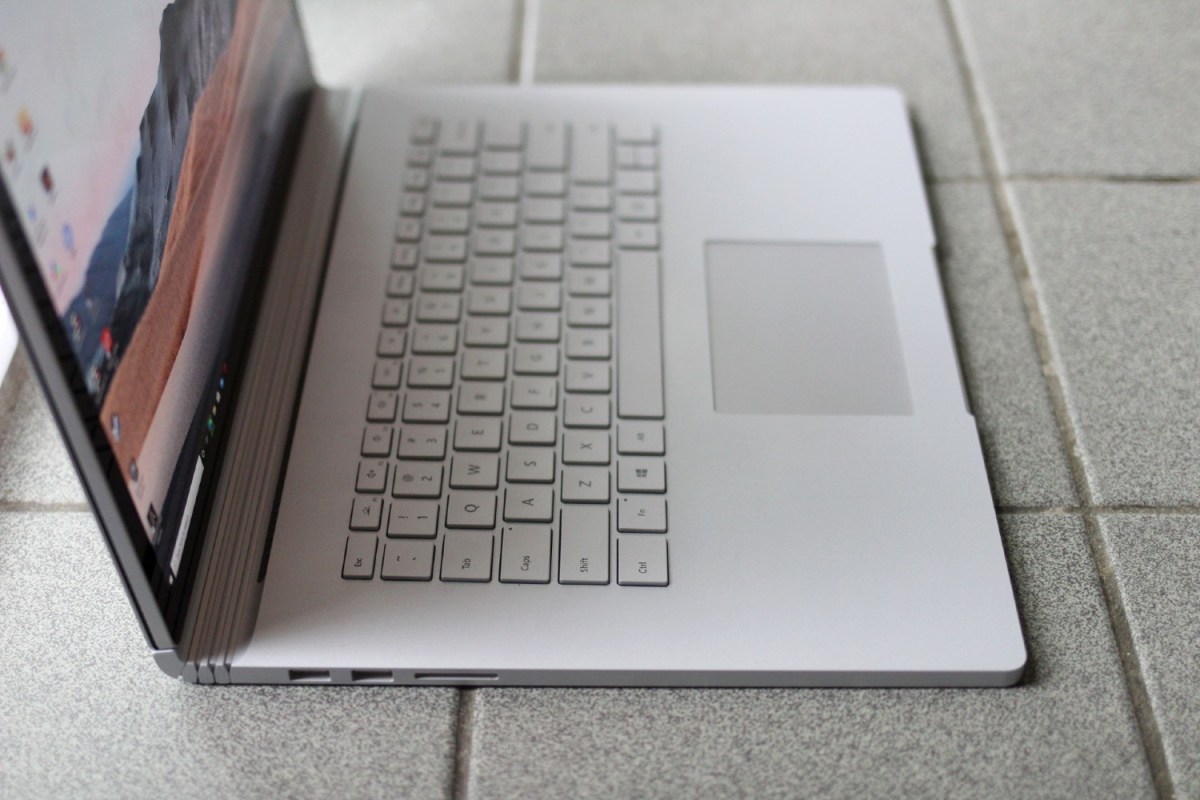
- Unique 2-in-1 design
- Big, sharp display
- Powerful graphics
- Great video editing performance
- Excellent keyboard
- Limited processor performance
- Very overpriced
- Reduced battery life
The Surface line has never been known to be as powerful as some of the best laptops money can buy. They’re devices that beg to be held, played with, and drawn on. Performance isn’t a weakness, but for most Surface devices, it comes second to design.
That’s been a problem for the Surface Book. It’s the one Surface product Microsoft often touts as having “powerhouse performance” — particularly in the large 15-inch model.
The latest version, the Surface Book 3, doubles down on this performance promise with better graphics via the Nvidia GTX 1660 Ti and updated Intel processors. But don’t be fooled — the Surface Book 3 still doesn’t have the heart of a true workstation laptop. Does that hold it back?
Performance

Performance is the only major change in the new Surface Book, so let’s start there. The Surface Book 3 bumps up both its processor and GPU to the latest Intel and Nvidia silicon, respectively. In this case, it’s the 10th-gen Intel Core Ice Lake processors and the Nvidia GTX 1660 Ti. My review unit came with a Core i7, 16GB of RAM, and a 1TB SSD.
CPU performance on its own isn’t impressive for a device this large. There’s one primary reason for this: It uses the same 15-watt chip that appears in small laptops like the Dell XPS 13, Surface Laptop 3, and HP Spectre x360 13. This is important. Not only is that less power than the CPUs in most 15-inch laptops, it also only has four processing cores to work with. The Dell XPS 15, ThinkPad X1 Extreme, and 16-inch MacBook Pro all feature up to eight cores.
The difference in core count makes a massive difference in performance. Add four cores with a laptop like the Dell XPS 15, and you’ll see a 53% better score in Cinebench R20’s multi-core test than the Surface Book 3.
The 15-inch Surface Book 3 has an ace up its sleeve. Graphics.
It’s not that Microsoft is intentionally holding back performance. The Surface Book 3 has to contain most of its components — CPU, memory, and more — in its tablet portion. It all sits behind the screen, like an iPad or a Surface Pro. As much as I want Microsoft to conjure some engineering magic and toss in a 45-watt processor, there are limitations inherent in this design.
But the 15-inch Surface Book 3 does have an ace up its sleeve: Graphics. It now uses the Nvidia GTX 1660 Ti, and it comes in all configurations. And as we’ll see, the Surface Book 3 is able to use those graphics in a way other laptops can’t.
I loaded up a 2-minute 4K video project in Adobe Premiere and started rendering the clip to ProRes 422. To my surprise, the Surface Book 3 finished the task in just 5 minutes and 25 seconds. That is really fast. Despite having four extra cores, the XPS 15 only beat it by 30 seconds in that same rendering test. Options like the MacBook Pro or Razer Blade aren’t even close to this fast.
The Surface Book 3 is able to max out the load to its CPU and GPU at 100% at many points throughout the render time. The system is able to hand off the extra strain on the processor to the graphics card. This isn’t possible with a standard laptop where these hot components are all stuffed into the same chassis. On the Surface Book 3, the graphics card is located in the base, while the CPU and other components are located behind the screen.
Ironic, isn’t it? The same reason the Surface Book 3 is processor-capped is also what gives the graphics card so much room to breath. The only catch (and it’s a big one) is the fact this only applies to software capable of using the GPU. Demanding software that can’t tap into the GPU won’t benefit from the boost it can provide.

Of course, a powerful graphics card has other uses. Though the Surface Book 3 is anything but a gaming laptop, it surprised me with its gaming chops.
It posts a 33% increase in 3DMark’s Time Spy test over the Surface Book 2, which used the GTX 1060. While a laptop like the XPS 15 has a much more powerful processor, the GTX 1660 Ti helps the Surface Book 3 be a better gaming laptop. With the resolution set to 1080p and the graphics at Ultra, Battlefield V played at a smooth 60 frames per second. There’s not much point in going beyond that, as the Surface Book 3’s display refreshes at 60Hz.
The Surface Book 3 was particularly impressive in Assassin’s Creed Odyssey, a tough game that challenges even powerful gaming PCs. While the game was nearly unplayable on the XPS 15, the Surface Book 3 can handle it even at Ultra High settings at an average of 48 frames per second. Microsoft even fixed the battery issue that kept the Surface Book 2 from holding its charge while gaming.
Not all applications are ready to utilize the GPU in this way. You won’t have the same luck in Lightroom, and even video encoding software like Handbrake is limited to the CPU. The Surface Book 3 is painfully slow in these situations. Even smaller laptops like the Dell XPS 13 and the MacBook Pro 13-inch beat it out in video encoding, thanks to better thermals or higher-wattage processors.
So yes, the Surface Book 3 can be a powerful laptop, depending on the task at hand. It’s a surprisingly capable video-editing machine, and even a decent gaming laptop when you need it to be.
The Surface Book 3 as a tablet

The Surface Book 3 remains an adventurous design, even for Microsoft.
It’s a 2-in-1 like the Surface Pro, except that the screen attaches directly into the “dynamic fulcrum hinge” on the base. With an amazingly tight connection, the tablet portion plugs into the base to form a laptop experience with very few compromises.
With the push of a function key, the tablet pulls off with relative ease. You can even reattach the tablet backwards so it can be used for presentations or watching videos. It’s an intuitive alternative to using kickstands or magnets to hold the screen up.
The new Surface Book 3 works just like the original introduced four years ago.
I do miss the tablet kickstand, however. I often use tablets in the kitchen while cooking or cleaning, which the Surface Pro or iPad are both good for. There’s no way to prop up the Surface Book 3 without reattaching it to the large base. The lack of an adjustable kickstand also makes writing on the tablet a bit clumsy. It’s most comfortable attached to the base backward, with the keyboard flipped around.
In the era of the iPad Pro and Magic Keyboard, the Surface Book 3’s solution isn’t the only game in town. Despite the emphasis Microsoft puts on the experimental design of its products, the new Surface Book 3 works just like the original introduced four years ago.

The software also feels frozen in time. Windows 10 still lacks a robust, touch-ready app ecosystem and meaningful gesture support to make the tablet mode feel anything but supplemental. That’s more forgivable here than on the Surface Pro, but it rains on the parade of the impressive tablet hardware.
The tablet itself weighs just 1.8 pounds, which is a bit heavier than the 1.4-pound iPad Pro (12.9-inch). The total weight of the Surface Book 3 is a hefty 4.2 pounds, but for its size, the tablet feels remarkably light.
It’s easy enough to hold in one hand like a clipboard and use with the Surface Pen or scroll the web while lounging on the couch. The stylus doesn’t come bundled in, unfortunately, and wasn’t included with my review unit.
Battery life is the one major problem with tablet mode. Only a portion of the battery is available in tablet mode, because the battery is split between the tablet and keyboard dock. You can expect only a few hours of battery life from the tablet alone — long enough to watch a movie in bed, but not much more.
The Surface Book 3 as a laptop

More than the Surface Pro, the Surface Book 3 is meant to be a laptop-first experience.
Its obtuse hinge isn’t too noticeable with the laptop open, but it makes the device thicker. At its thickest point, it’s 0.90 inches. That’s a hard squeeze in many backpacks. It’s otherwise a sturdy, exceptionally well-built laptop. Just keep its size in mind before you buy.
Like all Surface products, the Surface Book 3 has a top-notch keyboard and touchpad. Because the keycaps sit above the keyboard deck, it’s an extremely tactile keyboard that replicates an external keyboard more than most laptop keyboards. If you miss that clickity-clack feel on modern laptops, you’ll love typing on the Surface Book 3.
Unless you’re a professional photo editor, you’ll thoroughly enjoy this big, crisp display.
The same goes for the glass touchpad, which has a quiet click mechanism and precise tracking. The touchpad is large enough, though I’d like to see it expanded. The MacBook Pro 16 has a larger trackpad, and even the new Dell XPS 15 has expanded the size to use every millimeter of the available space. There’s no reason the Surface Book 3’s couldn’t be larger.
The speakers aren’t located in the base of the laptop, but in the tablet itself. That makes for good positioning, with them pointed directly toward your ears. They aren’t the loudest or boomiest speakers in the world for watching movies, though.
You definitely won’t complain about the ultra-sharp 3,240 x 2,160 display. It’s a beautiful, high-contrast screen, and as long you stick to the sRGB color mode, it’s even color accurate. It’s not bright enough to compete with the MacBook Pro, nor is the color gamut wide enough. For everything other than professional photo editing, however, you’ll thoroughly enjoy this big, crisp display.

Because the chassis hasn’t changed in four years, the Surface Book 3 sticks to an older set of ports: Two USB-A, a full-sized SD card slot, the Surface Connect dock for power, and a USB-C port. The lack of Thunderbolt 3 is a glaring omission. Microsoft continues to avoid the high-powered, superfast port technology that nearly all its competitors use. As Dell moves to four Thunderbolt 3 ports on its XPS 15 and XPS 17, the Surface Book 3’s options are a bit stale.
Battery life is a key ingredient for the laptop experience, and the Surface Book 2 was a record-setter. Thanks to its two batteries — one behind the screen and one in the base — it lasted for 20 hours in local video playback. The Surface Book 3 still has a whopping 82 watt-hours of juice, and yet it’s battery life has been significantly reduced by more than 50% in some tests.
In local video playback, it lasts 13 hours and 42 minutes, while it’s closer to 8.5 hours in more moderate web browsing. It lasts me through the workday, but the huge reduction is quite disappointing. I suspect a firmware update could resolve the issue, but Microsoft hasn’t yet responded with an explanation.
Lastly, the price of the Surface Book 3 can’t be overlooked. The 15-inch model starts at a hefty $2,400, though it comes with just 256GB of SSD storage. Even the expensive 16-inch MacBook Pro starts with twice the storage for the same price. When you’re more expensive than a brand that’s already criticized by most as being overpriced, you’re in trouble.
The only way to add more storage to the Surface Book 3 is to spend at extra $400, which also bumps you up to 32GB of RAM. Limited configurations makes it hard to customize the Surface Book 3 exactly how you might want it.
Our take
The Microsoft Surface Book 3 remains a niche laptop, especially in its 15-inch form. The price is crazy, and the mediocre processor limits the kinds of work it excels at. However, the impressive graphics performance turns the Surface Book 3 into a solid video-editing and gaming machine. The unique design remains its primary draw, however,
Are there any alternatives?
The closest alternative to the Surface Book 3 are the other Surface products like the Surface Pro 7, Surface Pro X, or Surface Laptop 3. The Surface Laptop 3 is the only that also comes at this size, though it doesn’t offer a discrete graphics option.
If you can give up the tablet experience, the Dell XPS 15 and 16-inch MacBook Pro offer better processor performance. The XPS is also much cheaper.
How long will it last?
The Surface Book 3 should last you more than a few years. Because of its unique design, you won’t be able to upgrade the memory or storage on your own. The Surface Book 3 comes with a 60-day return policy and a year of in-store technical support, so as long as you live near a Microsoft Store. The warranty is a standard limited one-year contract.
Should you buy it?
Yes. Thanks to some powerful graphics, the Surface Book 3 is by far the most powerful Surface device ever made.
You can still consider discounted alternatives if the price is a concern. We can show you some of the best laptop deals and Microsoft Surface Pro deals if that’s the case.



